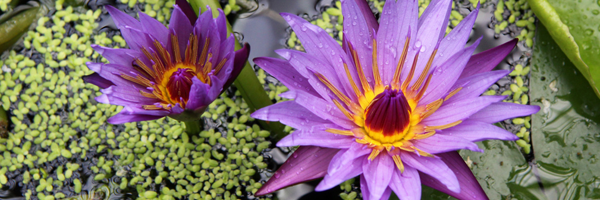 Water lilies are a wonderful way to add color and the coolness of water to your patio or landscape. A large pond or lake is not necessary for these floating beauties, they can be enjoyed in any container that holds water. They only need a depth of 18 inches and around 24 inches across. They come in submersible pots. Place them in at least partial sun. Water circulation is not necessary. Feed with Pond Tabs Fertilizer Tablets every month. Water lilies love heavy clay soil which we have plenty of. When your lily outgrows its pot, find a slightly larger pot, go dig up some clay dirt and mix with water, make a “mud pie”, place your lily in the new pot, pour your mud around it. It’s good to put some pebbles on top of the mud to help keep your water clean. Water gardens draw lots of fun bugs like dragonflies but also grow mosquitoes so be sure to
Water lilies are a wonderful way to add color and the coolness of water to your patio or landscape. A large pond or lake is not necessary for these floating beauties, they can be enjoyed in any container that holds water. They only need a depth of 18 inches and around 24 inches across. They come in submersible pots. Place them in at least partial sun. Water circulation is not necessary. Feed with Pond Tabs Fertilizer Tablets every month. Water lilies love heavy clay soil which we have plenty of. When your lily outgrows its pot, find a slightly larger pot, go dig up some clay dirt and mix with water, make a “mud pie”, place your lily in the new pot, pour your mud around it. It’s good to put some pebbles on top of the mud to help keep your water clean. Water gardens draw lots of fun bugs like dragonflies but also grow mosquitoes so be sure to  throw in a mosquito dunk, ok for good bugs…death to those flying vampires! Or put in a guppie or two and they will eat ’em up. Have Fun!
throw in a mosquito dunk, ok for good bugs…death to those flying vampires! Or put in a guppie or two and they will eat ’em up. Have Fun!
-Debbie



James says
I totally agree with you, I have had still water gardens before and they are actually a benefit in that they attract mosquitoes to lay their eggs where they will be eaten by your guppies, a.k.a. mosquito fish, or by dragonfly larva. And then those dragonfly larva will hatch out and eat more adult mosquitoes. An environmental benefit all the way around. But unfortunately, often rules are made to solve one problem and Are not flexible enough to allow for alternate and maybe even better solutions. In your case, if you install a recirculating pump with a water feature that does not create so much turbulence that it damages your lily pads then maybe they will consider that a solution to the “stagnant water” rule. It creates a little additional work for you keeping the pump clear of debris, but that may be the best way to handle your problem. Best of luck!
Jo Archer says
I have 2 300 gal. water gardens with water lilies and other plants and wild guppies. No mosquitoes no problems, also no pumps, filters or aerators. City Code Enforcement tells me that water that is not moving is “stagnant” and if I don’t correct the stagnant water I will be required to get rid of my ponds. Any suggestions? Aerators? filters? anything?
Thanks,
Jo Archer
James says
And if you think it would do any good for me To back up your argument, as an “expert”I would be happy to try.